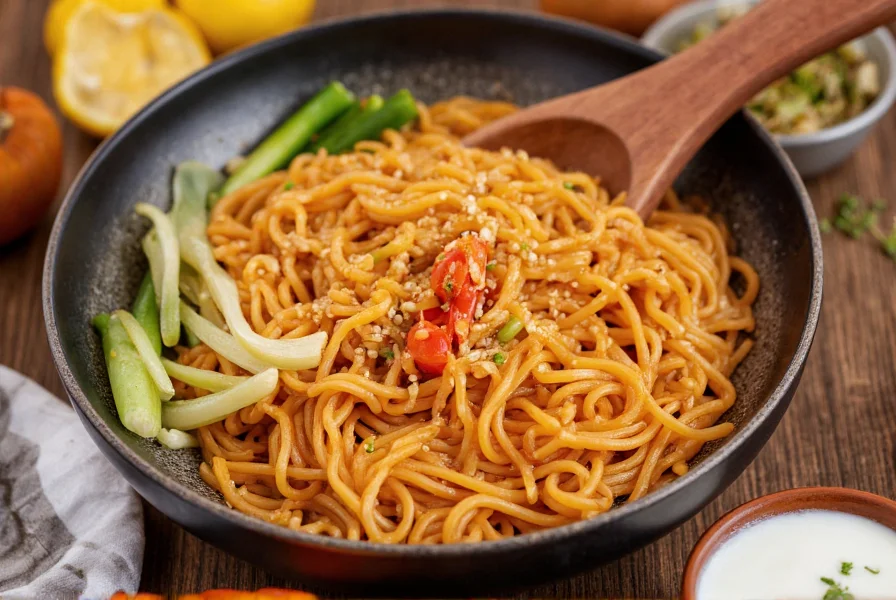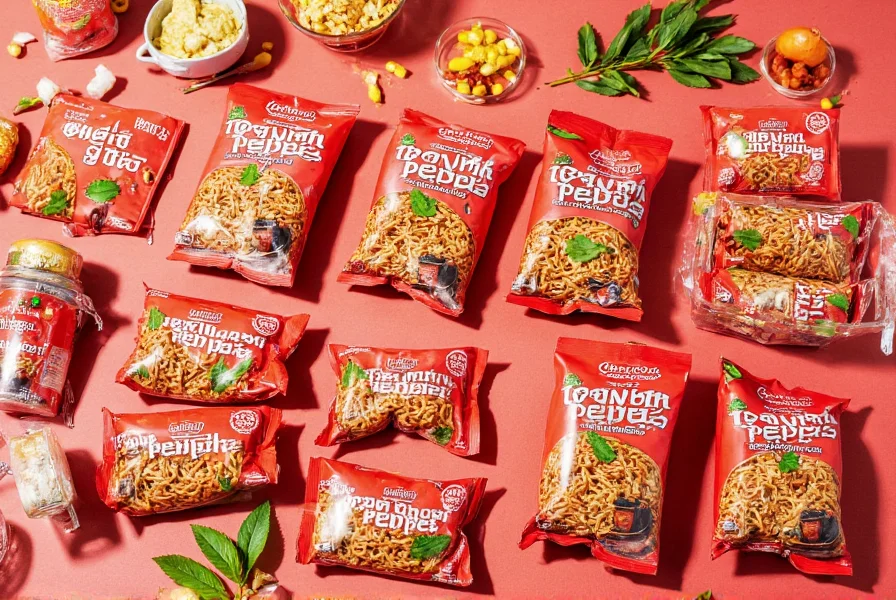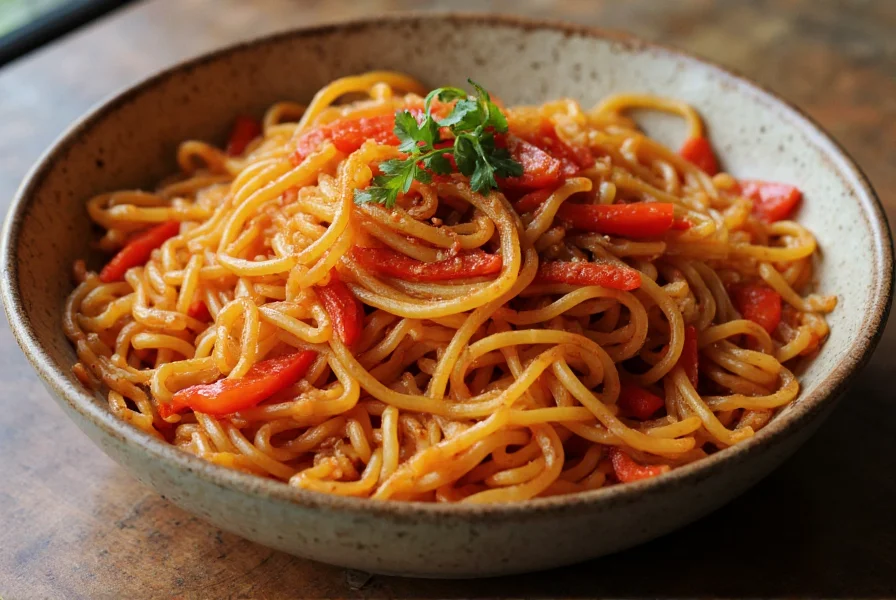Ghost pepper noodles have gained notoriety as one of the most challenging culinary experiences available to adventurous eaters. These instant or prepared noodles incorporate Bhut Jolokia (ghost pepper), which held the Guinness World Record as the world's hottest chili pepper from 2007 to 2011. Understanding what you're dealing with before attempting these noodles is crucial for both enjoyment and safety.
What Makes Ghost Pepper Noodles Different
Unlike standard spicy noodles that use cayenne or red pepper flakes, ghost pepper noodles contain actual Bhut Jolokia extract or powder. The ghost pepper's heat comes from concentrated capsaicinoids that trigger intense pain receptors. Most commercial ghost pepper noodle products contain between 0.1% to 0.5% ghost pepper by weight, but even this small amount creates an extreme experience.
Measuring the Heat: Scoville Scale Context
To understand ghost pepper noodles' intensity, consider these Scoville Heat Unit comparisons:
| Food Item | Scoville Heat Units (SHU) |
|---|---|
| Ghost pepper (fresh) | 800,000-1,041,000 SHU |
| Ghost pepper noodle seasoning | 300,000-500,000 SHU |
| Habanero pepper | 100,000-350,000 SHU |
| Sriracha sauce | 1,000-2,200 SHU |
| Tabasco sauce | 2,500-5,000 SHU |
The seasoning packet in ghost pepper noodle products typically contains concentrated ghost pepper extract, making them significantly hotter than eating the fresh pepper alone due to the direct application to the tongue and mouth.
Safety Considerations for Ghost Pepper Noodle Consumption
Before attempting ghost pepper noodles, consider these critical safety points:
- Do not consume on an empty stomach - The capsaicin can cause severe gastric distress
- Have dairy products ready - Milk or yogurt help neutralize capsaicin better than water
- Wear gloves when handling - Ghost pepper oil can transfer to eyes or sensitive skin
- Start with small portions - Many people cannot finish an entire serving
- Avoid if you have gastrointestinal conditions - Can exacerbate ulcers or IBS

What to Expect When Eating Ghost Pepper Noodles
First-time consumers often underestimate the delayed reaction of ghost pepper heat. Unlike milder spices, the full intensity typically hits 30-90 seconds after consumption. The experience generally follows this timeline:
- 0-30 seconds: Normal noodle flavor with mild warmth
- 30-90 seconds: Intensifying burn spreading across tongue and mouth
- 2-5 minutes: Peak heat causing sweating, flushed face, and possible tears
- 5-15 minutes: Sustained burn requiring cooling agents
- 15-60 minutes: Gradual subsiding of mouth burn
- Several hours: Possible stomach discomfort or digestive effects
Popular Ghost Pepper Noodle Varieties
Several brands have entered the extreme heat market with different approaches:
- Fire Noodles (Samyang) - The original viral sensation with both regular and extra spicy versions
- One Star Spicy Hot Noodles - Known for consistent extreme heat levels
- Bomb Noodles - Marketed specifically for competitive eating challenges
- DIY ghost pepper noodle kits - Allow customization of heat levels
When selecting ghost pepper noodles, check whether the product includes cooling elements in the seasoning packet. Some newer formulations include dairy powder to slightly moderate the heat while maintaining the challenge.

Recovery Strategies After Consumption
If you've overestimated your heat tolerance, these recovery methods work best:
- Dairy products - Whole milk, yogurt, or ice cream provide immediate relief
- Sugary drinks - Sugar helps break down capsaicin molecules
- Starchy foods - Bread or rice can absorb some capsaicin
- Avoid alcohol and carbonation - These can intensify the burning sensation
For severe reactions including difficulty breathing, persistent vomiting, or chest pain, seek medical attention immediately. While rare, extreme capsaicin exposure can trigger serious physiological responses.
Who Should Avoid Ghost Pepper Noodles
Certain individuals should completely avoid ghost pepper noodles:
- People with gastrointestinal disorders (IBS, ulcers, Crohn's disease)
- Those with respiratory conditions like asthma
- Individuals taking certain medications that interact with capsaicin
- Children under 18 (many products carry explicit age warnings)
- Anyone with known sensitivity to extremely spicy foods
The American Gastroenterological Association recommends against regular consumption of foods exceeding 350,000 SHU due to potential long-term digestive tract damage.
Responsible Enjoyment of Extreme Heat Foods
For those who enjoy the challenge of ghost pepper noodles, consider these responsible consumption practices:
- Eat with friends who can assist if you have a severe reaction
- Start with lower-heat varieties before progressing to ghost pepper
- Never consume multiple servings in one sitting
- Understand that building tolerance requires gradual progression
- Respect your body's limits - there's no shame in stopping early
Remember that ghost pepper noodles represent an extreme culinary experience, not an everyday meal option. The temporary endorphin rush that makes these noodles appealing to some carries genuine physical risks that shouldn't be taken lightly.
How hot are ghost pepper noodles compared to regular spicy foods?
Ghost pepper noodles typically measure between 300,000-500,000 Scoville Heat Units (SHU), making them 100-200 times hotter than standard spicy foods like Tabasco sauce (2,500-5,000 SHU) and significantly hotter than habanero peppers (100,000-350,000 SHU). The heat hits with a delayed reaction and lasts much longer than milder spicy foods.
What should I do if ghost pepper noodles are too hot?
Immediately consume dairy products like milk or yogurt, which contain casein that breaks down capsaicin. Avoid drinking water as it spreads the oil. Eat starchy foods like bread to absorb some capsaicin. If experiencing severe symptoms like difficulty breathing or persistent vomiting, seek medical attention immediately.
Can ghost pepper noodles cause permanent damage?
Occasional consumption typically doesn't cause permanent damage, but regular consumption of extreme-heat foods may contribute to long-term gastrointestinal issues. The American Gastroenterological Association warns against frequent consumption of foods exceeding 350,000 SHU due to potential damage to the digestive tract lining. Severe immediate reactions require medical evaluation.
How can I build tolerance to ghost pepper noodles?
Build tolerance gradually by starting with milder spicy foods and slowly increasing heat levels over weeks or months. Never jump directly to ghost pepper noodles. Consume spicy foods regularly but not excessively, allowing your body time to adapt. Always have cooling agents available, and never push beyond your physical limits as this can cause injury.
Are ghost pepper noodles safe for most healthy adults?
For most healthy adults without gastrointestinal conditions, ghost pepper noodles are safe when consumed responsibly and occasionally. However, they should never be treated as regular food items. The extreme heat can cause temporary but intense physical reactions including sweating, flushing, and stomach discomfort. People with certain medical conditions or taking specific medications should avoid them completely.











 浙公网安备
33010002000092号
浙公网安备
33010002000092号 浙B2-20120091-4
浙B2-20120091-4